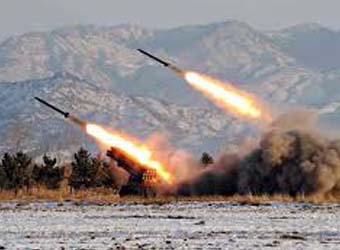An alert mistakenly warning Hawaiians of an imminent ballistic missile attack — at a time the state’s residents are already anxious about nuclear tensions between the U.S. and North Korea — resulted from human error, Hawaii’s governor said.
The emergency notice was triggered after an “employee pushed the wrong button” during a shift change at the Hawaii Emergency Management Agency, Governor David Ige said at a press conference. He apologized for the “pain and confusion” that resulted and said “everything” is being done to prevent a repeat.
The Federal Communications Commission, which has jurisdiction over the emergency alert system, is “launching a full investigation” into the incident, Chairman Ajit Pai said on Twitter. Federal and state lawmakers also called for a probe.
Residents of the island state, as well as thousands of tourists, woke around 8:07 a.m. local time on Saturday to alerts lighting up their mobile phones about — in all capital letters — a “ballistic missile threat inbound to Hawaii” and a warning that “this is not a drill.”
Television programming was interrupted with flashing red text: “A missile may impact on land or sea within minutes. This is not a drill. If you are indoors, stay indoors. If you are outdoors, seek immediate shelter in a building.” Residents were told that if indoors they should stay well away from windows. If driving, they should pull over and “seek shelter in a building or lay on the floor.”
President Briefed
Authorities reversed the warning with a second mobile alert sent 38 minutes later confirming “no missile threat or danger” and “false alarm.” The city of Honolulu, the state’s capital, confirmed “no threat” on its website several minutes earlier, and knockdowns were also made on Facebook and Twitter before the second mobile alert was sent.
In a statement, the White House said President Donald Trump had been briefed on what it described as “the state of Hawaii’s emergency management exercise.” Trump spent several hours Saturday at one of his golf courses in Florida.
HEMA Administrator Vern Miyagi said the errant message was triggered by one individual with an action that resembled “a mouse click.” He and Ige said a two-person redundancy system is now in place to prevent this type of event from occurring again.
‘Terrified’ Residents
“It was a false alarm based on human error,” Democratic Senator Brian Schatz said on Twitter, calling the incident was “totally inexcusable.” Schatz said Hawaii’s residents were “terrified. There needs to be tough and quick accountability and a fixed process.”
Representative Adam Schiff, the top Democrat on the House Intelligence Committee, said it was “unforgivable” that the false mobile alarm took so long to correct. “Congress must investigate,” the Californian said on Twitter.
Hawaii has been on high alert for months given claims by North Korea that its newest intercontinental ballistic missile could fly 13,000 kilometers (8,000 miles). If true, that would put even the mainland U.S. within range, and Honolulu is only about 7,400 kilometers from Pyongyang.
The isolated nation conducted its sixth and most powerful nuclear test on Sept. 3, and launched more than a dozen missiles in the past year. Trump has engaged in months of nuclear saber-rattling, and told North Korean leader Kim Jong Un on Twitter this month that he has a “much bigger” nuclear button.
‘Heightened Tensions’
“At a time of heightened tensions, we need to make sure all information released to the community is accurate,” Senator Mazie Hirono, a Democrat, said on Twitter. “We need to get to the bottom of what happened and make sure it never happens again.”
Representative Tulsi Gabbard of Hawaii, one of the first to confirm that the missile alert was false, later said on CNN that Trump was “taking too long” to deal with tensions surrounding North Korea, which contributed to dialing up the panic from Saturday’s incident.
“You’d be angry just like I am,” said Gabbard, a Democrat and a member of the House Armed Services Committee. “It points to the failure of our leaders that we are sitting here in a state where this threat, this text message, was a very real thing. Today’s one was mistake, but the reality is that this threat is very real.”
Miyagi said his agency had spent months working on how to alert residents of an impending missile strike, given current U.S.-North Korea tensions. “If this is real, there will be 12 to 13 minutes,” he said. “Please take this to heart.”
Panic, Pandemonium
Residents and tourists reported pandemonium when the phone alert hit. One video widely shared on social media showed children being lowered into a storm drain for safety; others showed people running toward buildings at the University of Hawaii.
Suzanne Mulder, a Bloomberg employee from Princeton, New Jersey, is vacationing in Honolulu with her family. Her 10-year-old-son noticed the mobile alert.
“We grabbed all the food and water we had, the kids grabbed their stuffed animals and we headed to the lobby,” Mulder said. “Kids crying everywhere, no one knew what was happening. We made our way to an internal bathroom and huddled there with some other people. It was probably 30 minutes between the alert and when we knew it was a false alarm.”
Source: Bloomberg
